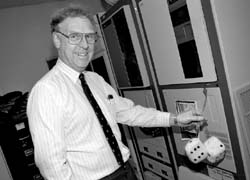Simulator builds better air traffic controllers
by Shaun Goho
 |
Professor Gerald Ratzer with some unusual mainframe accessories
[ ALL PHOTOS: OWEN EGAN ] |
Gerald Ratzer knows that the life of an air traffic controller isn't easy.
"It's an unbelievably stressful job," he explains. The hours are long, there are split-second decisions to be made, and the costs of an error are incalculably high. Not surprisingly, most countries are chronically understaffed.
"There is about a ten percent shortage [of air traffic controllers] worldwide," says Ratzer, a professor in the School of Computer Science.
In view of these numbers, and the ever-increasing levels of air traffic, the importance of fast and effective training programs for air traffic controllers is clear. Yet conventional programs are plagued by high drop-out rates. Those who do graduate usually face years of on-the-job apprenticeship before they are ready to work "on the front line" in a major airport.
This problematic situation is changing for the better, thanks in large part to the research of Ratzer himself. Ratzer develops air traffic control (ATC) training simulators, which give prospective air traffic controllers the same sort of training that pilots get from flight simulators.
Ratzer's latest simulator, developed in collaboration with ATS Aerospace of St. Bruno, is a remarkable piece of software. It produces a three-dimensional, virtual-reality environment. Trainees sit in a "virtual control tower," surrounded by a 360-degree "window." Up to three controllers can work together in what looks and feels like the main control tower at a large airport.
The collaboration between university and industry that produced this simulator was recognized in 1995 by the Natural Sciences and Engineering Research Council (NSERC), when they awarded Ratzer and ATS President Bill Friend a Synergy Research and Development award.
Their system allows one to train in a completely realistic, yet safe environment. It also allows the controllers' skills to be pushed to the limit. According to Amy Friend, executive vice president of ATS, "one can extend the flight load past what they would encounter on the job." After such rigorous training, the stresses of the real thing seem manageable in comparison.
The benefits of this system have been apparent in Austria, which in 1994 became the first country to purchase one of the ATS tower simulators.
"They tell us that students are at the same stage after a month as they used to be after four months," says Friend. In contrast to the usual lengthy apprenticeship, recent graduates of the Austrian centre have been able to go straight to work.
NAV Canada, a training institute for controllers in this country, has been using the simulator for only six months, but training manager Duncan MacPhee says it has already had a significant impact. "This is an extremely high-fidelity simulator. Expectations of instructional staff have increased--they may now perceive that using any lower-fidelity simulators is of no value."
Not one to rest on his laurels, Ratzer already has improvements for the simulator in mind. First, he wants to make the system more affordable.
"This system costs five million dollars. We now think we can do it for a tenth of the cost. Many countries can't afford a five-million-dollar system." Even so, more than 30 countries on five continents have Ratzer/ATS simulators.
The NSERC Synergy award, which specifically recognizes industry-university collaborations, represents a change of attitude from when Ratzer began his research.
"Thirty years ago if a prof ever stepped outside the university it was called moonlighting," recalls Ratzer. "I remember that one prof had a consulting contract, and a lot of people complained about it."
According to Amy Friend, universities still do not make enough of an effort to market the products they produce. "Too many good things remain on the shelf," she says. Collaborations with industry can ensure that such products do get out.
Ratzer thinks that such collaborations can also benefit students. "It's a plus to be able to bring real industrial experience into a course that you're teaching," he explains. Many of his students have taken projects which they have done for him into job interviews, and have been "hired on the spot."
He cites the example of Pierre Goyette, creator of the TCP3270 software which is widely used to connect personal computers to mainframes over the internet. The latest version of TCP3270 was recently purchased by Hummingbird in a multi-million dollar deal (Reporter, January 30). "Pierre Goyette was a student of mine; he did [the first version of] this as an honours project for me."
Ratzer also has an innovative approach to teaching his undergraduate courses at McGill. This semester, he has begun to offer his Computers in Engineering course entirely through the World Wide Web. Most of the course materials--including a 450-page textbook, interactive quiz questions and samples of past mid-term and final exams--are available electronically.
"We're running a little pilot study this term," he reports. "We have about 10 students who have promised not to come to class."
Most students are pleased with the result. One student has said, "I'm really enjoying this course, enjoying being able to do it on my own. I feel that I'm learning more this way."
For Ratzer, helping people to learn more, whether they be ATC trainees or McGill students, seems to be his chief aim.
"I think that getting bright students interested and motivated, and giving them a rich learning experience is something that is very valuable. I enjoy seeing people on their way to a good career."
Shaun Goho , a master's student in biology, is a participant in the Reporter's Science Writing Internship Program. The program, based on an initiative at the University of Guelph, is sponsored by NSERC.